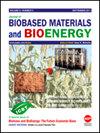Screening of Fatty Acids Profile and Antioxidant Activities with the Antibacterial Activities of Saussurea costus Essential Oil
IF 0.5
4区 医学
引用次数: 0
Abstract
The essential oil of Saussurea costus trunk and the roots contains important amount of polyphenols; alkaloids and terpenes. The S. costus was milled into powder for lipid extraction, fatty acid profile and antiradical approach at several concentrations (1000, 800, 400, 200 μg mL−1) using DPPH radical scavenging capacity. Escherichia coli, Staphylococcus aureus, Staphylococcus sciuri, Salmonella typhi, Pseudomonas aeruginosa and Salmonella enterica were used as bacteria growth indicators for antibacterial activities. 18 fatty acid concentrations (by percentage) were evaluated in the fatty acid profile. The major fatty acid was (9,12,15-Octadecatrien-1-ol,(Z, Z, Z)) which recorded (18.59%) followed by (Eremanthin) 14.70% and (Bicyclo[4.4.0]dec-2-ene-4-ol, 2-methyl-9-(prop-1-en-3-ol-2-yl)) 11.86%. (Gama-eudesmol) recorded the lowest value 0.07%, while (Furoscrobiculin B), (Iso-Velleral), and ((-)-Spathulenol) 0.08% were the minor fatty acids in S. costus. The results presented a relatively larger amount of (Hexadecanoic acid, methylester (CAS)) and (à-Ionone) from 8.26%–1.55%, respectively. S. costus at 1000 μg mL−1 concentration exhibited the highest antioxidant activity. S. costus extract reported high antioxidant activity with high amounts of essential fatty acids. S. costus as a medicinal plant proved to be highly active due to its phytochemical bioavailability. Results revealed that the highest zone of inhibition 22.10 mm was detected by 50 μl/mL for Staphylococcus aureus which was the most sensitive, while Salmonella typhi recorded the lowest zone of inhibition 9.92 mm by 10 μl/mL which as the most resistance. Additional researches are on animals are required to confirm the beneficial effects of the plant extract.雪莲精油脂肪酸谱及抗氧化活性与抗菌活性的筛选
雪莲干、根精油中含有大量的多酚类物质;生物碱和萜烯。利用DPPH自由基清除能力,在不同浓度(1000、800、400、200 μg mL−1)下将木香磨成粉末,进行脂质提取、脂肪酸谱分析和抗自由基检测。以大肠杆菌、金黄色葡萄球菌、严重葡萄球菌、伤寒沙门氏菌、铜绿假单胞菌和肠炎沙门氏菌作为细菌生长指标进行抑菌活性测定。在脂肪酸谱中评估了18种脂肪酸的浓度(按百分比)。主要脂肪酸为(9,12,15- octadecatrien -1-ol,(Z, Z, Z)),占18.59%,其次为(Eremanthin) 14.70%,(Bicyclo[4.4.0]dec-2-ene-4-ol, 2-methyl-9-(pro- 1-en-3-ol-2-yl) 11.86%。(Gama-eudesmol)含量最低,为0.07%,(furroscobiculin B)、(isovelleral)和((-)- spathulenol)为0.08%。结果表明,十六酸(Hexadecanoic acid)、甲酯(methyl lester, CAS)和(à-Ionone)的含量较高,分别为8.26% ~ 1.55%。1000 μ mL−1浓度下木香的抗氧化活性最高。木香提取物具有高的抗氧化活性,含有大量的必需脂肪酸。木香作为一种药用植物,由于其植物化学生物利用度高而被证明具有很高的活性。结果表明,对金黄色葡萄球菌最敏感,用50 μl/mL检测出最高抑制带22.10 mm;对伤寒沙门菌最耐药,用10 μl/mL检测出最低抑制带9.92 mm。需要在动物身上进行更多的研究来证实植物提取物的有益作用。
本文章由计算机程序翻译,如有差异,请以英文原文为准。
求助全文
约1分钟内获得全文
求助全文

 求助内容:
求助内容: 应助结果提醒方式:
应助结果提醒方式:


